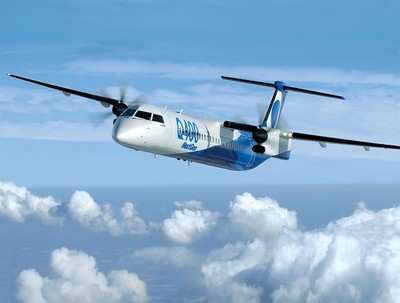Fri, Nov 04, 2011
New RNP Procedures Lower Decision Heights, Visibility
Requirements
A study of airspace around Sun Valley Airport has identified
significant improvements in airport access that could be achieved
during periods of inclement weather with the deployment of new,
advanced instrument approach procedures. The study, conducted by
GE, found that new procedures, using Required Navigation
Performance (RNP) technology, would allow Bombardier Q400 passenger
turboprops, like the ones operated by Horizon Air, to operate at
Sun Valley on days of low ceiling and visibility that currently
force diversions and cancellations.
File Photo

In addition to lowering decision heights and visibility
requirements for commercial carriers, new RNP procedures could also
provide benefits to general aviation and business aircraft
operators at Sun Valley, depending on aircraft type, crew training
and performance capabilities.
Based on study findings, the deployment of new optimized RNP
approach paths would allow Q400 Turboprops to land at Sun Valley on
days during the year when weather conditions currently prevent them
from operating. Unlike other possible alternatives for improving
access at Sun Valley airport, the deployment of advanced RNP
procedures would require no additional ground infrastructure,
either on or off the airport property. "The beauty of RNP is that
it relies on performance characteristics of the aircraft itself,
incorporating GPS, advanced instrumentation and computer-based
navigation capabilities, to define a very precise trajectory," said
GE Aviation Technical Fellow Steve Fulton. "The technology frees
the aircraft from the constraints of ground-based radio-navigation
infrastructure," Fulton said. "That means we can continuously
improve the procedures without the need to add additional
ground-based equipment."
After the RNP procedures are deployed, over time, they could be
optimized to further lower decision heights, reduce visibility
requirements, and allow RNP operations by multiple aircraft types.
GE Aviation's study was conducted in cooperation with Horizon Air
and general aviation operators, and was underwritten by airport
users who value reliable air service into the Wood River
Valley.
More News
Light Gun A handheld directional light signaling device which emits a brilliant narrow beam of white, green, or red light as selected by the tower controller. The color and type of>[...]
"The journey to this achievement started nearly a decade ago when a freshly commissioned Gentry, driven by a fascination with new technologies and a desire to contribute significan>[...]
Aero Linx: JAARS, Inc. For decades now, we’ve landed planes on narrow rivers and towering mountains. We’ve outfitted boats and vehicles to reach villages that rarely se>[...]
"Our driven and innovative team of military and civilian Airmen delivers combat power daily, ensuring our nation is ready today and tomorrow." Source: General Duke Richardson, AFMC>[...]
Aircraft Conflict Predicted conflict, within EDST of two aircraft, or between aircraft and airspace. A Red alert is used for conflicts when the predicted minimum separation is 5 na>[...]
 ANN's Daily Aero-Term (04.20.24): Light Gun
ANN's Daily Aero-Term (04.20.24): Light Gun Aero-News: Quote of the Day (04.20.24)
Aero-News: Quote of the Day (04.20.24) ANN's Daily Aero-Linx (04.21.24)
ANN's Daily Aero-Linx (04.21.24) Aero-News: Quote of the Day (04.21.24)
Aero-News: Quote of the Day (04.21.24) ANN's Daily Aero-Term (04.21.24): Aircraft Conflict
ANN's Daily Aero-Term (04.21.24): Aircraft Conflict



